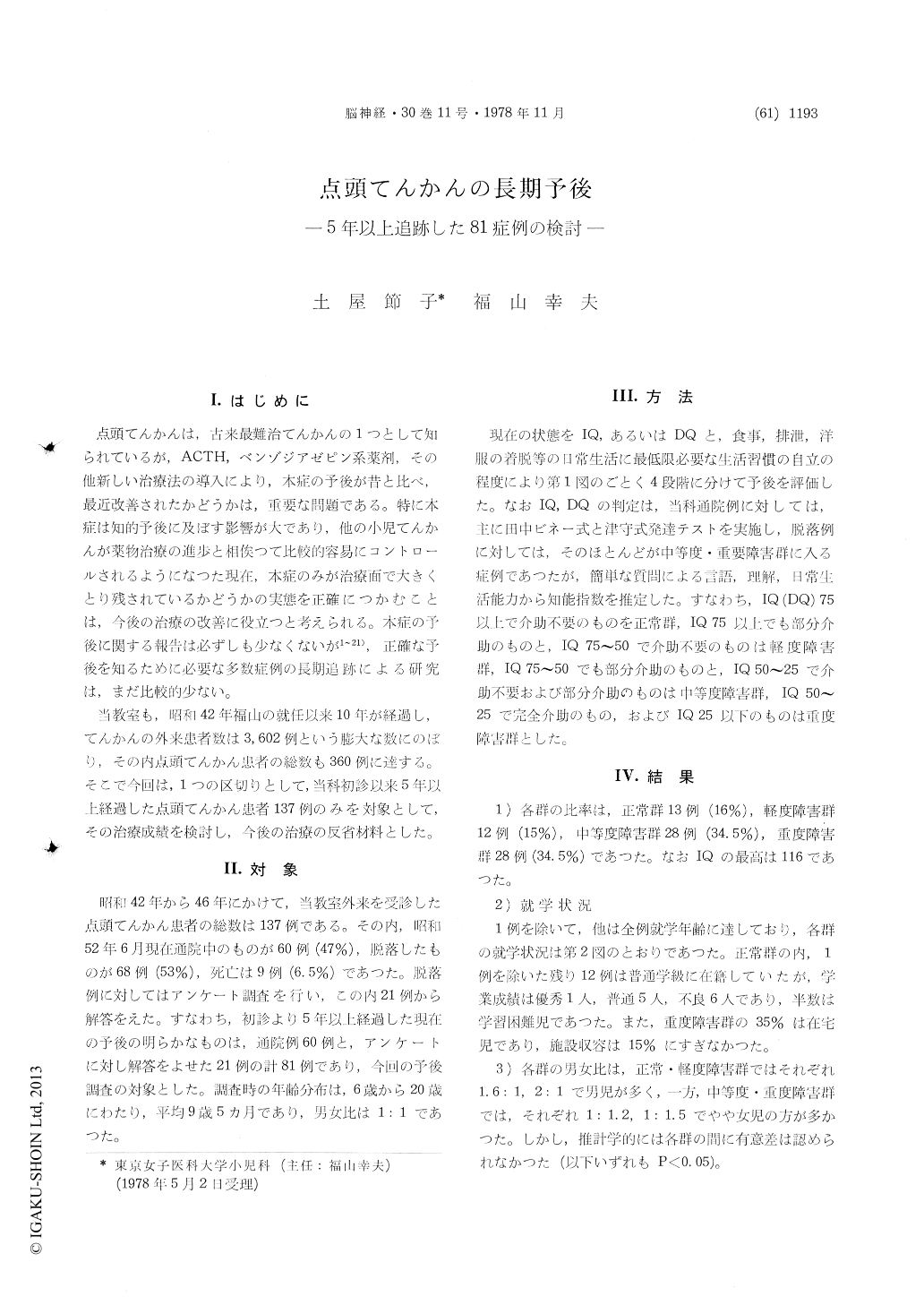Japanese
English
- 有料閲覧
- Abstract 文献概要
- 1ページ目 Look Inside
I.はじめに
点頭てんかんは,古来最難治てんかんの1つとして知られているが,ACTH,ベンゾジアゼピン系薬剤,その他新しい治療法の導入により,本症の予後が昔と比べ,最近改善されたかどうかは,重要な問題である。特に本症は知的予後に及ぼす影響が大であり,他の小児てんかんが薬物治療の進歩と相俟つて比較的容易にコントロールされるようになつた現在,本症のみが治療面で大きくとり残されているかどうかの実態を正確につかむことは,今後の治療の改善に役立つと考えられる。本症の予後に関する報告は必ずしも少なくないが1〜21),正確な予後を知るために必要な多数症例の長期追跡による研究は,まだ比較的少ない。
当教室も,昭和42年福山の就任以来10年が経過し,てんかんの外来患者数は3,602例という膨大な数にのぼり,その内点頭てんかん患者の総数も360例に達する。そこで今回は,1つの区切りとして,当科初診以来5年以上経過した点頭てんかん患者137例のみを対象として,その治療成績を検討し,今後の治療の反省材料とした。
Eighty one children with infantile spasms were followed up over 5 years ; 60 cases were studied by regular visits to the clinic and 21 cases were studied through information obtained by follow-up questionnaire. Nine of 81 patients (6.5%) had died before 6 year-old. All cases except three were treated with ACTH-Z.
The percentage figures for the prognosis of all cases in regards to the main factors of clinical importance were as follows:
a) Normal group-13 patients (16%) had normal mentality (IQ>75) and could help themselves in daily living without assistance.
b) Mild handicapped group-12 patients (15%) were those who had normal mentality but could not help themselves in daily living without assistance and those who had slightly subnormal mentality (IQ 75-50) but could help themselves in daily living without assistance.
c) Moderately handicapped group-28 patients (34.5%) were those who had slightly subnormal mentality and could not help themselves in daily living without assistance and those who had moderately subnormal mentality (IQ 50-25) and could help themselves in daily living with or without assistance.
d) Severe handicapped group-28 patients (34.5%) were those who had moderately subnormal mentality unable to carry on any useful activity and those who had severe mental deficit (IQ <25).
The factors on which the long-term prognosis may depend were as follows ; The prognosis for survival was better in females and the prognosis for mentality was better in males. Those children whose development had been normal up to the onset of spasms (cryptogenic) and spasms ceased until the age of 1 year without relapse and who had been treated within 3 months after the onset of spasms had a good prognosis. A bad prognosis was associated with abnormal development prior to the onset of spasms, neurological abnormality (usually cerebral palsy), relapse with minor motor seizures or Lennox syndrome and persistence of E.E.G. abnormalities (multifocal spikes, diffuse spike and wave, or poly-spike and wave complex).

Copyright © 1978, Igaku-Shoin Ltd. All rights reserved.


